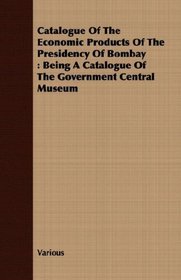Search -
Catalogue Of The Economic Products Of The Presidency Of Bombay: Being A Catalogue Of The Government Central Museum
Catalogue Of The Economic Products Of The Presidency Of Bombay Being A Catalogue Of The Government Central Museum
Author:
CATALOGUE OF THE ECONOMIC PRODUCTS OF THE PRESIDENCY OF BOMBAY BEING A CATALOGUE OF THE GOVERNMENT CENTRAL MUSEUM. DIVISION I.-RAW PRODUCE VEGETABLE. COMPILED BY ASSISTANT SURGEON BIRDWOOD. - PREFACE. THIS work was at first meant to be a simple catalogue of the economic specimens from the vegetable kingdom belonging to the Museum. But as these d... more »
Author:
CATALOGUE OF THE ECONOMIC PRODUCTS OF THE PRESIDENCY OF BOMBAY BEING A CATALOGUE OF THE GOVERNMENT CENTRAL MUSEUM. DIVISION I.-RAW PRODUCE VEGETABLE. COMPILED BY ASSISTANT SURGEON BIRDWOOD. - PREFACE. THIS work was at first meant to be a simple catalogue of the economic specimens from the vegetable kingdom belonging to the Museum. But as these d... more »
ISBN-13: 9781406780451
ISBN-10: 1406780456
Publication Date: 9/10/2007
Pages: 376
Rating: ?
ISBN-10: 1406780456
Publication Date: 9/10/2007
Pages: 376
Rating: ?
0 stars, based on 0 rating




